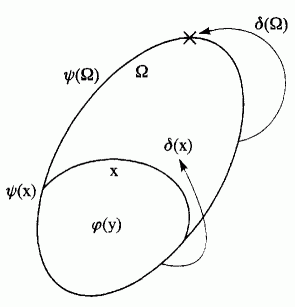
INCLOSURE SCHEMA
As we have seen . . . all the paradoxes of self‑reference (including Berkeley's Paradox and the Fifth Antinomy) are inclosure contradictions; that is, they all instantiate the Inclosure Schema, which, to remind the reader, concerns properties φ and ψ, and a function δ such that:
(1) Ω = {y; φ(y)} exists and ψ(Ω) Existence
(2) if x ⊂ Ω and ψ(x) (a) δ(x) not-∈ x Transcendence
(b) δ(x) ∈ Ω Closure
One might depict these conditions as in Figure 1. The large oval is Ω, the set of all φ things. x is any subset of Ω satisfying ψ, and δ applied to this takes us out of x but into Ω. Applying δ to Ω takes us both into and out of Ω. This is somewhat difficult to depict(!). I have done so by taking δ(Ω) to be a spot on the boundary of Ω. [1]

1 There is something rather appropriate about this. The boundary is, in its own way, paradoxical, both joining and separating the inside and the outside.
Source: Priest, Graham. Beyond the Limits of Thought, 2nd ed. (Oxford: Clarendon Press; New York: Oxford University Press, 2002), p. 156.
Note: I can't find a readable symbol for the following, so:
not-∈ = not an element of
Graham Priest,
Paraconsistent Logic, and Philosophy, Or, Logic and Reality
by R. Dumain
Graham Priest vs Erwin Marquit on Contradiction by R. Dumain
“What is the Relationship Between Logic and Reality?” by R. Dumain
Philosophy of Paraconsistency & Associated Logics (Web Guide)
Home Page | Site
Map | What's New | Coming Attractions | Book
News
Bibliography | Mini-Bibliographies | Study
Guides | Special Sections
My Writings | Other Authors' Texts | Philosophical
Quotations
Blogs | Images
& Sounds | External Links
CONTACT Ralph Dumain
Uploaded 8 February 2007
Site ©1999-2014 Ralph Dumain